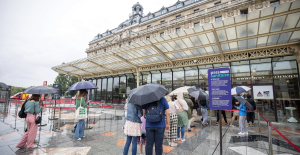This article is taken from the Figaro Hors-Série: Ramsès II, the event exhibition at the Grande Halle de la Villette.You are like Rê in everything you do. If you desire something during the night, the morning has quickly come. We have been told of a multitude of wonders since you were crowned King of the Two Lands. This is how the princes of the Court express themselves in a stele found in Kuban, which relates the drilling of a well in the desert of Lower Nubia. When it comes to finding gold, courtiers push deference quite far. Because the region is rich in deposits, but the lack of water prevents any exploitation. Seti I had already broken his teeth there. No gold without water. And in a desert, no water without a miracle. By succeeding where his father had failed, Ramses kills two birds with one stone: he enlarges the fortunes of the Crown and presents himself as the providential man. It adds a chapter to the great story of the pharaohs. Thus continues the plea of the courtiers: "If you say to the water, 'Come out of the mountain!', the flood will come quickly after your words, for you are Ra incarnate. " No sooner said than done.
In 1276 BC, the third year of the reign, it is fortunate that the elements obey Pharaoh. Because the mines of wadi el-Hammamat, to the east of Thebes, no longer suffice for the expenses of the kingdom. Everywhere, one builds or one renovates – Ramses set up a service of restoration of the royal tombs in Abydos. It is not just construction sites that require such abundant resources. The kingdom of Hatti preoccupies the sovereign. A war, secretly, is preparing. To the three divisions already existing, Ramses adds a fourth, the division of Seth. That makes a total of more than twenty thousand men, infantry and charrerie combined. Among them, many foreigners, Nubian archers or Shardanes, those pirates defeated by Ramses, who now serve in the ranks of the Egyptians. But the loyalty of a mercenary is highly variable. One buys it more surely by a good balance than by fine speeches.
Pi-Ramses, the new capital, is under construction east of the Delta. Why this move of the Court to the north? No doubt the Sun King wanted to build his city, and to build it not far from the border from which the expeditions departed. The city of basins and canals, located on the edge of the “water of Rê”, an arm of the Nile, was immediately famous for its gardens. It is also for its barracks. Since his return from the festivities in Thebes, in year 1 of the reign, Ramses has had his eyes turned towards the East, where Thutmose, before him, had forged his legend. Qadesh, won by his father Seti, was taken over by the Hittite. This needs to be fixed. Finally, there is Amurru, located in the north of present-day Lebanon, a buffer region between the Hittite enemy and Phenicia, under Egyptian control. Its king, Benteshina, is also threatened by the expansionism of the Hittites. So many signs of serious competition in the Middle East, which require a response to match.
In year 4 of the reign, Ramses engages an expeditionary force in the "path of Horus", the military track that his father had marked out with citadels, from Tjarou to Gaza. He returns two months later, having consolidated his suzerainty over Amurru. This rapid expedition is the prelude to the great campaign that Ramses has been planning with his generals since he learned that his rival Muwatalli, king of Hatti, was gathering a vast coalition against him. We are talking about a massive army, quite heterogeneous it is true, because it is made up of a multitude of vassal tribes, allies, or simply lured by gain. The Near East presents itself at this time as a mosaic of city-states subject to the influence of the Hatti in the north, of Egypt in the south. At the crossroads of Anatolia, Africa and Mesopotamia, at the confluence of caravan routes and maritime routes, this area is the object of all desires. Whoever holds it has wealth and power in Asia. Also it was already the scene of many clashes under the XVIIIth dynasty. At the heart of this region, between the steps of the Euphrates and the Mediterranean, the Orontes valley crystallizes imperial ambitions. It is in Kadesh that the inevitable conflict will take place.
Ramses II, the event exhibition at the Grande Halle de la Villette, 164 pages, €13.90, available on newsstands and on Le Figaro Store.

 B:SM will break its investment record this year with 62 million euros
B:SM will break its investment record this year with 62 million euros War in Ukraine: when kyiv attacks Russia with inflatable balloons loaded with explosives
War in Ukraine: when kyiv attacks Russia with inflatable balloons loaded with explosives United States: divided on the question of presidential immunity, the Supreme Court offers respite to Trump
United States: divided on the question of presidential immunity, the Supreme Court offers respite to Trump Maurizio Molinari: “the Scurati affair, a European injury”
Maurizio Molinari: “the Scurati affair, a European injury” Irritable bowel syndrome: the effectiveness of low-carbohydrate diets is confirmed
Irritable bowel syndrome: the effectiveness of low-carbohydrate diets is confirmed Beware of the three main sources of poisoning in children
Beware of the three main sources of poisoning in children First three cases of “native” cholera confirmed in Mayotte
First three cases of “native” cholera confirmed in Mayotte Meningitis: compulsory vaccination for babies will be extended in 2025
Meningitis: compulsory vaccination for babies will be extended in 2025 Thanks to intelligent cameras, RATP will indicate the least crowded trains on line 14
Thanks to intelligent cameras, RATP will indicate the least crowded trains on line 14 Dubai begins the transformation of Al-Maktoum to make it the future “largest airport in the world”
Dubai begins the transformation of Al-Maktoum to make it the future “largest airport in the world” When traveling abroad, money is a source of stress for seven out of ten French people
When traveling abroad, money is a source of stress for seven out of ten French people Elon Musk arrives in China to negotiate data transfer and deployment of Tesla autopilot
Elon Musk arrives in China to negotiate data transfer and deployment of Tesla autopilot Two people arrested for attempted damage to classified property at the Musée d’Orsay
Two people arrested for attempted damage to classified property at the Musée d’Orsay Death of composer Jean Musy, at 76, author of the music of Papy fait de la resistance, Les Champs-Élysées
Death of composer Jean Musy, at 76, author of the music of Papy fait de la resistance, Les Champs-Élysées Fanny Ardant prodigious in The Wound and the Thirst
Fanny Ardant prodigious in The Wound and the Thirst Hospitalized for pneumonia, Véronique Sanson cancels her concert in Nantes
Hospitalized for pneumonia, Véronique Sanson cancels her concert in Nantes Skoda Kodiaq 2024: a 'beast' plug-in hybrid SUV
Skoda Kodiaq 2024: a 'beast' plug-in hybrid SUV Tesla launches a new Model Y with 600 km of autonomy at a "more accessible price"
Tesla launches a new Model Y with 600 km of autonomy at a "more accessible price" The 10 best-selling cars in March 2024 in Spain: sales fall due to Easter
The 10 best-selling cars in March 2024 in Spain: sales fall due to Easter A private jet company buys more than 100 flying cars
A private jet company buys more than 100 flying cars This is how housing prices have changed in Spain in the last decade
This is how housing prices have changed in Spain in the last decade The home mortgage firm drops 10% in January and interest soars to 3.46%
The home mortgage firm drops 10% in January and interest soars to 3.46% The jewel of the Rocío de Nagüeles urbanization: a dream villa in Marbella
The jewel of the Rocío de Nagüeles urbanization: a dream villa in Marbella Rental prices grow by 7.3% in February: where does it go up and where does it go down?
Rental prices grow by 7.3% in February: where does it go up and where does it go down? Europeans: a senior official on the National Rally list
Europeans: a senior official on the National Rally list Blockade of Sciences Po: the right denounces a “drift”, the government charges the rebels
Blockade of Sciences Po: the right denounces a “drift”, the government charges the rebels Even on a mission for NATO, the Charles-de-Gaulle remains under French control, Lecornu responds to Mélenchon
Even on a mission for NATO, the Charles-de-Gaulle remains under French control, Lecornu responds to Mélenchon “Deadly Europe”, “economic decline”, immigration… What to remember from Emmanuel Macron’s speech at the Sorbonne
“Deadly Europe”, “economic decline”, immigration… What to remember from Emmanuel Macron’s speech at the Sorbonne These French cities that will boycott the World Cup in Qatar
These French cities that will boycott the World Cup in Qatar Mercato: Fonseca coach of AC Milan? The Lille coach speaks
Mercato: Fonseca coach of AC Milan? The Lille coach speaks Ligue 1: OM with a three-way defense, Lens changes almost nothing
Ligue 1: OM with a three-way defense, Lens changes almost nothing Ligue 1: PSG officially crowned champion of France for the 12th time
Ligue 1: PSG officially crowned champion of France for the 12th time Ligue 1: Lyon offers Monaco and gets closer to a European place
Ligue 1: Lyon offers Monaco and gets closer to a European place

















